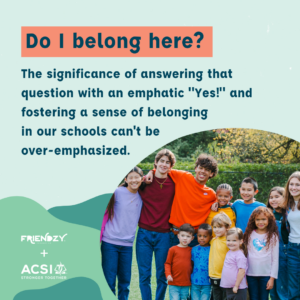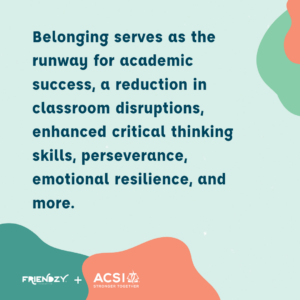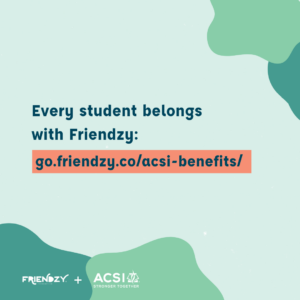The Power of Belonging

Every morning, students step into the sights and sounds of a new school day. The peppering of book bags across the school lawn and blurs of denim in the hallway become constants and coefficients in a complex set of equations:
Do I belong here? Am I safe? Do my peers and teachers care about me?
God has hardwired us for community. Barely two chapters into Genesis, a profound problem is declared: “It is not good for the man to be alone” (Gen 2:18). And though we continue to evolve into the most technologically connected generation of humans, these increasingly accessible digital tools have only widened the valley of our collective social disconnection. God has formed us with a deep desire to belong. We are designed to crave connection.
Studies show that when we yearn for social interaction, our brains are activated in the same region where we see activity when we crave food (Tomova et al., 2020). Social exclusion also shows up in the same part of our brain where we register pain (Macdonald, Leary, 2005).
As educators, we can make a difference in the lives of our students. Students who feel seen, known, loved, and cared for at school are more likely to have greater academic success, self-motivation, and a willingness to keep trying when things are challenging (Freeman, Anderman & Jensen, 2007). Relationships act as a protective barrier for our students. These meaningful connections we make with our students help them manage stress and anxiety while building their ability to be resilient when working through challenging situations (Durlack et al., 2017). The power of belonging is profoundly beautiful; our relationships with our students are the manifestation of God’s perfect design for His children. We are truly better together.
It is not just through our words but through our morning hello’s and encouraging notes, our thoughtful classroom setup and modeling of kindness, our engaging lessons, and our gentle coaching that we say to our students you were meant to be in my classroom, and I am glad you are here. And a child that believes that message is a child that spreads that sense of belonging to their peers. Our classrooms are a petri dish! Through one student who spends one moment with one caring adult, the spark of belonging is kindled.
Here are five simple ways to build a sense of belonging in your classroom.
- Daily Check-in: This daily check-in tool is a brief burst of time for you to connect with your students and understand how they show up in your classroom. This can be done individually with a student, or it can be a classroom activity. The practice of checking in with each other builds community and connection. It teaches students to recognize their own emotions and feelings and equips them to connect with others. When teachers acknowledge their students’ emotions, it demonstrates care and concern for that student; students feel seen and known. Here are a few ways you can acknowledge your students’ emotions:
- Ask open-ended questions: “Is there something about today that has been hard for you?”
- Use I statements: “I know you are angry; it’s not fun to feel overwhelmed.”
- Validate their feelings: “I can understand how that could make you upset.”
- Warm Welcomes & Peer Engagement: A warm welcome sets the tone for every student to feel seen, heard, and known, creating a positive and safe learning environment. This habit shapes how students engage with each other and develops a sense of collective identity and belonging. Here is a slide deck with 14 quick and easy ways to foster peer-to-peer connections.
- Meaningful Conversation Stems: Conversation stems create space for open-ended discussions so students can hold their peers accountable, demonstrate active listening skills, and have meaningful conversations. Nonverbal hand signals are gestures that allow students to participate in classroom conversation in a respectful, orderly, and engaged manner. This tool allows every student to participate and be heard. Check out this free conversation stem tool for your classroom.
- Use Names: Our brains receive a hit of dopamine whenever we hear our name. Greeting students when they return from lunch and throughout the day helps them feel recognized and valued.
- Pray Together: Praying as a group allows students to support each other by sharing their burdens and joys. This routine fosters a sense of belonging, as students feel acknowledged and heard by both God and their classmates.
The concept of belonging is rooted in the greatest commandment found in Matthew 22:37-39:
“‘Love the Lord your God with all your heart and with all your soul and with all your mind.’ This is the first and greatest commandment. And the second is like it: ‘Love your neighbor as yourself.'”
When we create classrooms that foster belonging, students experience God’s love and are encouraged to extend that same care to others.



References
Durlak, J. A., Domitrovich, C. E., Weissberg, R. P., & Gullotta, T. (2017). Handbook of Social and Emotional Learning: Research and Practice. The Guilford Press.
Freeman, T. M., Anderman, L. H., & Jensen, J. M. (2007). Sense of belonging in college freshmen at the classroom and campus levels. Journal of Experimental Education, 75(3), 203–220. https://doi.org/10.3200/JEXE.75.3.203-220
Macdonald, G., & Leary, M. R. (2005). Why does social exclusion hurt? The relationship between social and physical pain. Psychological bulletin, 131(2), 202–223. https://doi.org/10.1037/0033-2909.131.2.202
Osterman, K. F. (2000). Students’ need for belonging in the school community. Review of Educational Research, 70(3), 323-367. http://proxymu.wrlc.org/login?url=https://www.proquest.com/scholarly-journals/students-need-belonging-school-community/docview/214111717/se-2
Tomova, L., Wang, K.L., Thompson, T. et al. Acute social isolation evokes midbrain craving responses similar to hunger. Nat Neurosci 23, 1597–1605 (2020). https://doi.org/10.1038/s41593-020-00742-z
About the Author
.jpg?sfvrsn=bae7c4e7_0)

More Blog Posts
-
Dr. Jay Ferguson | January 6, 2025
-
Chris Loncar | December 17, 2024
-
Dr. Mitch Evans | December 10, 2024
-
Melanie Waisukirawa | December 3, 2024
More ACSI Blog Posts
-
Dr. Jay Ferguson | January 6, 2025
-
Chris Loncar | December 17, 2024
-
Dr. Mitch Evans | December 10, 2024







.jpg?sfvrsn=ced8e73c_1)
.jpg?sfvrsn=5674fd67_0)
9c5b36e2a5ee4143a2b5ab77d1a04820.jpg?sfvrsn=92b57781_0)
.jpg?sfvrsn=a9b91091_0)